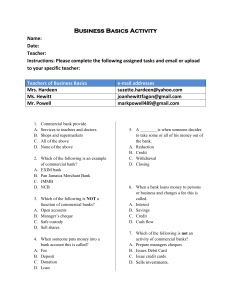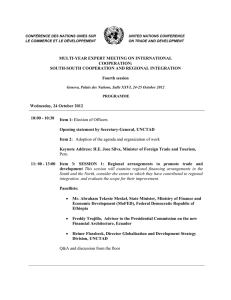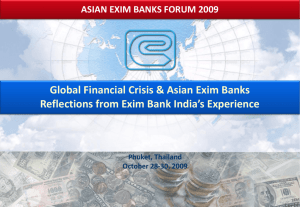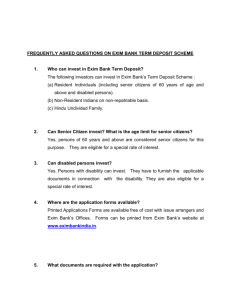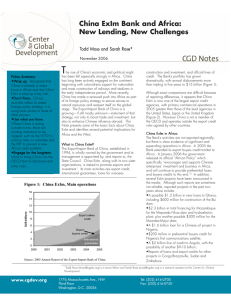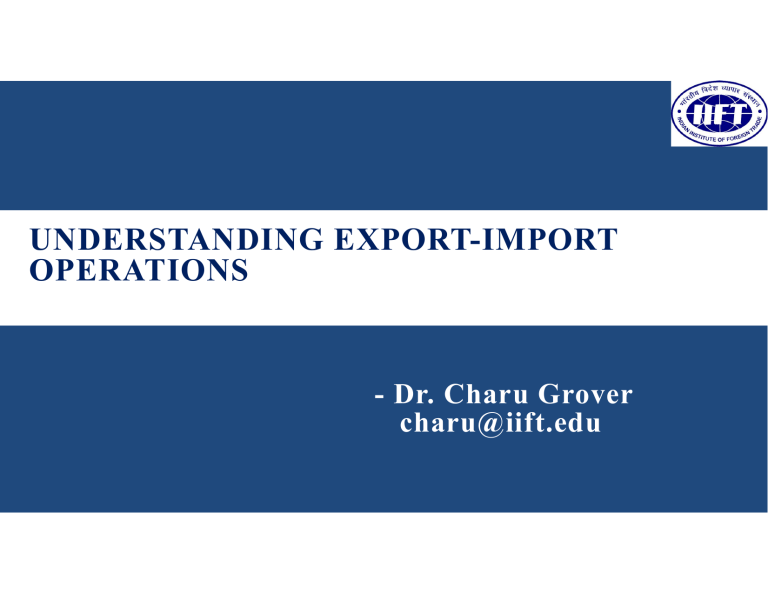
UNDERSTANDING EXPORT-IMPORT OPERATIONS - Dr. Charu Grover charu@iift.edu INTRODUCTION Exporting and Importing are most established form of international involvement for firms – both goods and services for increased global business opportunities. To increase economic integration countries sign preferential and free trade agreements (FTA) --- FTA with SAARC (South Asian Association of Regional Cooperation's), FTA with ASEAN Countries (Association of South East Asian Countries) India has adopted a foreign trade policy (FTP) 2023 INDIA’S KEY EXPORT PARAMETERS Rank-wise Leading Rank-wise Leading List of Countries Exporter (2021) Importers (2021) by FDI (2017) 1. China 2. United States 1. United States 2. China 1. Netherlands 2. United States 3. Germany 4. Japan 3. Germany 4. Japan 3. United Kingdom 4. China 5. Netherlands 18. India 5. United Kingdom 6. India 5. Ireland 19. India Source: United Nations CUSTOM WATER OF INDIA BALANCE OF TRADE Export Import Balance of Trade Favorable Balance of Trade Types of Balance of Trade Unfavorable Balance of Trade Equilibrium in Balance of Trade DOMESTIC VERSUS EXIM BUSINESS 1. Higher Distance Involved in EXIM Transactions than in domestic Transactions. No restrictions on movement of goods to any place in India. However, for EXIM transactions, the permission of Indian customs is required. 2. Difference in rules and regulations governing EXIM and domestic transactions – Only GST is applicable for supply of goods and services in India from 1st July 2017. Exports are free from taxes, even taxes imposed on imports used to manufacture the exportable goods are refunded as duty drawback. On imports, there is Integrated GST (IGST) 3. Dissimilarity in currencies used for payment in EXIM and domestic transactions 4. Difference in legal system – In EXIM transactions, need to adjust their practices DOMESTIC VERSUS EXIM BUSINESS 5. Difference in availability of Resources – Eg. India has trained pool of manpower but lacks capital- In EXIM transactions trade focus on factor advantages, which is not much in domestic transactions 6. Level of competition is higher in EXIM transactions as compared to domestic transactions 7. Access to information is easier in domestic transactions as compared to EXIM transactions 8. Business Infrastructure required for EXIM transactions will be at different levels of development than required for domestic transactions WHAT ARE THE RISKS? CARRIER BUYER (Importer) WHAT ARE THE RISKS ? PAYMENT BANK GOODS SELLER (Exporter) MANAGING RISKS IN EXIM OPERATIONS 1. Credit Risk 2. Foreign Exchange Fluctuation Risk 3. Importer’s Country Risk 4. Quality Risks 5. Cargo Risks 6. Cultural and Language Risks RULES MAKERS AND RULE MAKERS WATCHDOGS International banking transactions in IndiaIN are Rule ARE based & highly regulated by INTERNATIONAL TRADE TRANSACTIONS INDIA RULE BASED & multiple agencies. HIGHLY REGULATED BY MULTIPLE AGENCIES. Reserve bank of India – Responsible for efficient management of forex reserve – Master directions and AP (Dir) Circulars for Ads Customs Department – Monitors the movement of goods and the value the same. FEDAI (Foreign Exchange Dealers Association of India) DGFT - Nodal agency controlling country’s foreign trade & rules for export promotion and import rationalization through Foreign trade policy (FTP). EPCs/EIC/CBs ICC (International Chamber of Commerce ) ECGC- Political and commercial risk coverage International Chamber of Commerce Established in 1919 Private International Organisation Not a governmental body Paris based. Main business partner of the United Nations and its agencies. ICC’s Primary Objectives Facilitating the flow of international trade at a time when nationalism and protectionism posed threats to the world trading system Set rules and standards that would establish uniformity in practice, universal acceptance RULES….. UCPDC 600 (2007 Revision) ISBP 745 (2013 Revision) INCOTERMS (2020 Revision) URC 522 (1995 Revision) ISP 98(1998 Revision) ELEMENTS OF SUCCESS IN EXIM OPERATIONS 1. Export Planning of Firm 2. Understanding Foreign Cultures, Business Etiquettes and Practices 3. Hard work, Dedication, Devotion and Reliability 4. Product Adaptation and Labelling Requirements 5. Identifying Customers’ Wants and Needs 6. Managing Financial Resources 7. Positive Attitude and Futuristic Thinking 8. Effective Coordination and Communication 9. Documentation Knowledge Essential LABELLING - VIABLE SOURCE OF INFORMATION INTERNATIONAL CARRIAGE SYMBOLS THE WORLD OF LABELLING Blue Angel Eco Label for Eco label Eco 1977 Textiles 1995 Netherland Canada Germany Germany 1992 Label Eco label South Korea INDIA’S RANK VIS-À-VIS MAJOR EXPORTERS IN WORLD (2019) Rank Country Billion $ of Exports 1 2 China 2498 United States 1645 3 4 Germany Netherlands 1486 709 5 18 Japan India 705 334 Source: UN Comtrade IMPORTANCE OF EXIM TRADE TO NATION 1. To Meet Imports of Industrial Needs 2. Debt Servicing 3. Rapid Economic Growth 4. Profitable Use of Natural Resources 5. Dealing with Competition Successfully 6. Increase in Employment Opportunities 7. Role of Exports in National Income 8. Increase in Standard of Living RISING % OF IMPORT CONTENTS OF INDIA’S EXPORT Year % of Import Contents 1995 2000 9.33 11.27 2005 2010 17.45 22.25 2015 2019 24.03 24.73 Source: World Bank TOTAL DEBT SERVICE (% OF EXPORTS OF GOODS, SERVICES) Country 2001 2011 2012 2013 2014 2015 2019 India 17.92 6.41 6.70 8.07 18.51 10.91 14.01 Source: World Bank COUNTRIES GIFTED WITH NATURAL RESOURCES Country Russia United States Saudi Arabia Iran China Brazil Australia Iraq Main Natural Resources Coal, Oil, Gold, Gas Natural Gas, Gold, Copper Gas, Timber, Oil Natural Gas and Oil Coal and Timber Gold and Uranium Coal, Iron Ore, Timber, Copper Oil and Natural Gas IMPORTANCE OF EXIM TRADE TO INDUSTRY 1. Lack of Domestic Demand 2. Legal Restrictions 3. Higher Productivity and Profitability 4. Social Responsibility 5. Technological Improvements 6. Managing Seasonal Ups and Downs 7. Greater Opportunities for International Collaboration THANK YOU


